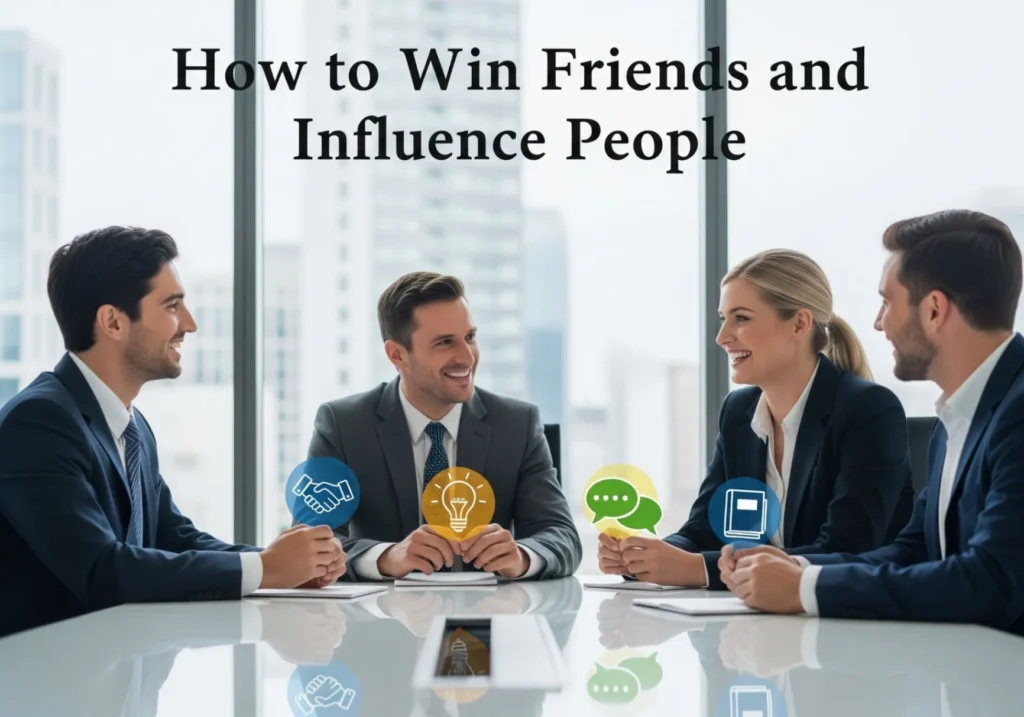Timeless Influence: How Dale Carnegie’s 1936 Secrets Still Win Friends in the Digital Age

Introduction: The Social Superpower
Ever sent an email that was completely misinterpreted? Pitched an idea that fell on deaf ears? Perhaps you found yourself in an awkward silence at a networking event, desperately wishing you could build a genuine connection?
In our hyper-connected, yet often disconnected, world, effective communication, persuasion, and leadership are not just “soft skills.” They’re superpowers. We constantly navigate Slack channels, Zoom meetings, client negotiations, and team collaborations. The quality of these interactions directly dictates the quality of our professional and personal lives.
What if the most effective operating manual for this social superpower was written not by a Silicon Valley guru last year, but by a former pork salesman from Missouri in 1936?
Dale Carnegie’s How to Win Friends and Influence People is a phenomenon. It has sold over 30 million copies. Translated into dozens of languages, it remains a fixture on bestseller lists nearly a century after its publication. Warren Buffett, one of history’s most successful investors, famously said that Carnegie’s lessons changed his life.
But in an age of social media, AI, and remote work, can a book from the Great Depression era still hold its ground? Is it a timeless guide to human nature or an outdated manual for manipulative charm?
The answer, as we’ll explore in this deep dive, is clear. Its principles are not only relevant but perhaps more crucial than ever. Carnegie didn’t write about fleeting social hacks. Instead, he codified the fundamental algorithm of human interaction.
This isn’t just a summary. This is your modern-day playbook for implementing Carnegie’s wisdom. We’ll break down every principle from all four parts of the book. We’ll translate them for the 21st century. Finally, we’ll give you actionable steps to start winning friends and influencing people—authentically and effectively—today.
Part 1: Fundamental Techniques in Handling People
Before you build bridges, you must first learn not to burn them. These three principles form the bedrock of human interaction.
Principle 1: Don’t Criticize, Condemn, or Complain.
“Criticism is futile because it puts a person on the defensive and usually makes him strive to justify himself. Criticism is dangerous, because it wounds a person’s precious pride, hurts his sense of importance, and arouses resentment.”
Carnegie’s point is stark: if even a notorious killer like “Two Gun” Crowley didn’t blame himself, what hope do you have of making an everyday person accept your criticism?
The 21st-Century Spin:
This principle is on steroids in the digital world. A hastily written critical email or Slack message lacks tone and appears 10x harsher than intended. Public criticism (“calling someone out”) on social media can ignite a firestorm of digital outrage.
Actionable Takeaway: Seek to Understand, Not to Criticize
Instead of: “This report is full of typos and misses the key data point.”
Try: “Thanks for getting this report over to me. I had a question about the data on page 4, and I noticed a few small areas we could polish up. Do you have 10 minutes to walk through it together?” This shifts the dynamic from accusation to collaboration.
Principle 2: Give Honest and Sincere Appreciation.
Carnegie distinguishes sharply between appreciation and flattery. Flattery is insincere and selfish. Appreciation is sincere, selfless, and comes from the heart. While people crave feeling important, they can spot a fake a mile away.
The 21st-Century Spin:
In the modern workplace, this is the secret sauce of employee engagement. A paycheck buys a person’s time, but appreciation buys their loyalty and discretionary effort. A public shout-out in a team meeting can be more motivating than a small bonus.
Actionable Takeaway: Be Specific and Sincere
Instead of: “Good job on the presentation.”
Try: “I was really impressed with how you handled that tough question from the VP during the presentation. You stayed calm and answered with data, which made our whole team look great.” This shows you were paying attention and valued a specific skill.
Principle 3: Arouse in the Other Person an Eager Want.
“The only way on earth to influence other people is to talk about what they want and show them how to get it.”
Carnegie used the analogy of fishing: he loved strawberries and cream, but he baited the hook with what the fish wanted—worms. The key is to frame your proposal through the lens of the other person’s interests.
The 21st-Century Spin:
This principle powers every successful sales pitch, marketing campaign, and job application. A great cover letter doesn’t say, “I need a job.” It says, “I see your company’s challenge, and my skills can help you solve it.”
Actionable Takeaway: Ask Two Questions Before Persuading
Before any important conversation, pause and ask yourself:
- What does this person truly want? (Security, recognition, control, purpose?)
- How does my proposal help them get what they want?
Always approach the conversation from their point of view first.
Part 2: Six Ways to Make People Like You
This section isn’t about being popular. It’s about creating the foundation of trust that makes influence possible.

The Six Principles of Likeability:
- Become Genuinely Interested in Other People. You can make more friends in two months by being interested in others than in two years by trying to get them interested in you.
- Smile. A genuine smile is a universal welcome mat. It costs nothing but creates so much. On a video call, a conscious smile changes the entire mood.
- Remember That a Person’s Name Is the Sweetest Sound. Using someone’s name is a subtle but powerful compliment. Double-check the spelling in emails!
- Be a Good Listener. Encourage Others to Talk About Themselves. Give the gift of your undivided attention. Close your laptop in meetings. Put your phone away.
- Talk in Terms of the Other Person’s Interests. The royal road to a person’s heart is to talk about the things they treasure most. A 5-minute LinkedIn search before a meeting can provide a powerful opening.
- Make the Other Person Feel Important—and Do It Sincerely. Adopt the mindset that you can learn something from everyone. Acknowledge their expertise and respect their time.
Part 3: How to Win People to Your Way of Thinking
This is a masterclass in negotiation, sales, and diplomacy. Its core theme is the avoidance of arguments and the art of gentle persuasion.
The Twelve Principles of Persuasion:
- The Only Way to Get the Best of an Argument Is to Avoid It. You can’t win an argument. Even if you “win” the point, you lose the goodwill.
- Show Respect for the Other Person’s Opinions. Never Say, “You’re Wrong.” This is a direct challenge that invites conflict. Instead, say “I may be wrong, let’s examine the facts.”
- If You Are Wrong, Admit It Quickly and Emphatically. This disarms the other person and robs them of the chance to attack.
- Begin in a Friendly Way. A drop of honey catches more flies than a gallon of gall.
- Get the Other Person Saying “Yes, Yes” Immediately. Build a path of agreement with questions they must agree with.
- Let the Other Person Do a Great Deal of the Talking. Resist the urge to talk. Ask questions and listen; they may persuade themselves.
- Let the Other Person Feel That the Idea Is His or Hers. Plant a seed and let them take credit for it.
- Try Honestly to See Things from the Other Person’s Point of View. Understand their motives before you make your request.
- Be Sympathetic with the Other Person’s Ideas and Desires. Acknowledge the validity of their feelings, even if you disagree with their position.
- Appeal to the Nobler Motives. People like to think of themselves as honorable and fair-minded. Frame your request around these values.
- Dramatize Your Ideas. Make your points vivid and interesting. Show, don’t just tell.
- Throw Down a Challenge. For spirited people, competition and the desire to excel are powerful motivators.
Part 4: Be a Leader: How to Change People Without Giving Offense
This section transforms social skills into a sophisticated leadership philosophy.

The Nine Principles of Effective Leadership:
- Begin with Praise and Honest Appreciation. It’s like the anesthetic a dentist uses before drilling.
- Call Attention to People’s Mistakes Indirectly. Instead of a direct attack, use a subtle approach.
- Talk About Your Own Mistakes Before Criticizing the Other Person. This makes feedback feel like mentoring, not judging.
- Ask Questions Instead of Giving Direct Orders. This empowers people and encourages cooperation.
- Let the Other Person Save Face. Don’t humiliate someone, even if you are 100% in the right.
- Praise the Slightest Improvement and Praise Every Improvement. This positive reinforcement is a powerful catalyst for growth.
- Give the Other Person a Fine Reputation to Live Up To. Act as though they already possess the trait you wish to cultivate.
- Use Encouragement. Make the Fault Seem Easy to Correct. Give people confidence that they can improve.
- Make the Other Person Happy About Doing the Thing You Suggest. Frame requests in a way that aligns with their interests.
The Verdict: Timeless Wisdom or Manipulation?
This is the most common criticism of Carnegie’s work. But these principles are a tool, and like any tool, they can be used for good or ill. The true power of the book is unlocked only when you embrace its core, unspoken principle: Be Genuine.
The book is not a manual for faking it. It’s a guide to retraining your default settings from a self-centered perspective to an other-centered one. It’s about cultivating a genuine curiosity, developing real empathy, and learning to communicate with respect.
This isn’t manipulation. It’s emotional intelligence.
Final Thoughts: Your Social Algorithm for the 21st Century
Reading How to Win Friends and Influence People is like finding the source code for human interaction. The user interface has changed—from face-to-face to Slack DMs—but the underlying operating system of human nature remains remarkably consistent. People still crave appreciation. They still hate criticism. They still respond to kindness, empathy, and respect.
Don’t just read these principles. Choose one. Practice it for a week. Start small. The results will be dramatic. You’ll find your interactions becoming smoother, your relationships stronger, and your influence growing—not through tricks, but through a genuine and respectful engagement with the people around you. That is the timeless, and priceless, secret of Dale Carnegie.





Let’s Discuss!
What do you think? Which of Carnegie’s principles resonates most with you in today’s world? Share your thoughts in the comments below!